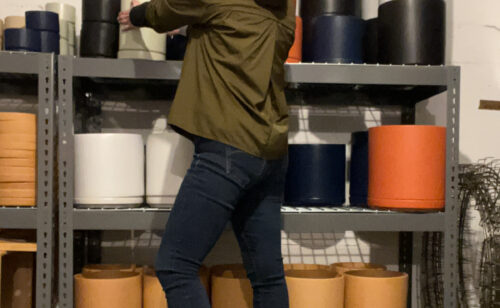
As the cost of living and inflation rises, it’s both increasingly important and challenging to offer employees a fair wage. At the same time, very few of us aim to run a shop that feels out-of-reach to our consumers from an affordability perspective. Is it really possible to run a small brick-and-mortar business that prices competitively, pays employees well, gives back to the community, and still makes a profit? How do we make sustainable and ethical businesses work in the current economy?
This content was initially produced as a panel discussion with small business owners like yourselves. You can watch a recording of the full panel discussion. We’ve summarized some key takeaways in this blog post, but as it was an active discussion, it’s well worth watching the recording!
We feel incredibly fortunate that these brick-and-mortar owners joined the conversation, speaking openly and honestly about decisions they’ve made for their businesses. They’ve shared what’s been working for them, what hasn’t worked, what they’ve learned, and how they’ve adjusted through the turbulence of the past couple of years.
We had some technical difficulties and the first part of the video got cut off, so I’d like to introduce our participants.
Here’s our host, Katherine:
Hi! I’m Katherine. I own a plant and flower shop with two locations in Tacoma, Washington called The Fernseed. We’ve been in business for three years and we have seven employees, including myself. It was a lifelong dream of mine to own a brick-and-mortar shop. I truly believe that independent storefront businesses are an indelible part of what makes a town or city a real “place.” But running a shop, especially in the past few years, has been incredibly challenging.
I found that there weren’t a lot of resources available brick-and-mortar retail business owners — at least not ones that were honest, actionable, and not written by a software company trying to convert us into customers. So I started writing a Substack about my experiences called Storefront Revolt in an effort to create community (and bonus: get some things off my chest). Before I opened my shop, I actually worked for Aeolidia. So when I started writing Storefront Revolt, Arianne reached out to me about writing more brick-and-mortar focused content for Aeolidia readers. She and I both knew that while the majority of Aeolidia’s audience is focused on e-commerce, there still are a lot of us running storefronts, and we could really use some support right now.
And our panelists:
Kat Gordon of Muddy’s Bake Shop
Kat has grown her Memphis bakery since 2008, and now teaches classes, throws parties, has had multiple locations, made it through the pandemic, has a mobile treat truck, and supports their local community, all while giving great perks and benefits to her employees.
Shelley Barandes of Albertine Press
Shelley has been in business with her letterpress printing company since 2005. Her physical and ecommerce shops sell products made in her studio, as well as products sourced from other small, independent makers, supporting local makers in Cambridge, MA, women-owned businesses, sustainable living, and thoughtful gifting.
Virginia Johnson of Gather Here
Gather Here (also in Cambridge) is part sewing studio, part fabric, and yarn shop. Virginia has been in business since 2011 and is part of a powerful community of craft artisans and busy bees who believe handcrafted, handmade goodness is for everyone.
Anna VonRosenstiel of Carter + Rose
Carter + Rose makes and curates beautiful, handmade goods in their online store and brick & mortar shop in Portland Oregon. They love supporting other artists and creating ceramics using local Oregon clay.
We’re all at different stages in our businesses and we hope you’re inspired, not daunted, by what these business owners have accomplished – because, frankly, they’re amazing.
Don’t compare your beginning to someone else’s middle.
Katherine Raz
Product Pricing, Profitability, and Price Sensitivity in Small Business
Handmade products, by their very nature, cost more than mass-produced items. They’re also often a purchase that’s made with discretionary income. So, in an economic climate where many consumers feel price-sensitive, how can a brick-and-mortar specializing in handmade goods strike the right balance between charging a fair amount and not being too expensive?
Educating customers about what goes into making a handmade item is one key component, Katherine pointed out. This education begins with training the staff. Virginia mentioned that Gather Here invests a lot in their team so that each staff member is equipped to talk about where a product is from, and what it’s made of, as well as explain fluctuations in prices.
In fact, if I never hear a complaint that my prices are too high, I should suspect that prices are too low!
Kat Gordon
When possible, offering a diverse range of products can help alleviate price-sensitivity. Bakery owner Kat points out that while some of her customers may not have the budget for an entire birthday cake, offering individual cupcakes gives them an accessible price point. At Gather Here, focusing on natural fibers helps the store remain curated and cohesive in spirit while giving the flexibility to include products for smaller budgets.
Kat emphasizes the need for clear pricing. While a certain item may not be within a customer’s budget, visible pricing helps avoid an awkward moment of sticker shock at the register.
Increasing Employee Wages + Benefits as a Small Business
The cost of living is increasing, and employees are finding their rent, transportation, and food to be more expensive than ever before. As business owners, we know that quality staff is the lifeblood of our businesses. It’s important to pay employees a competitive wage not just for humanitarian reasons, but also because it’s almost always more cost-effective to retain an employee than to hire and train a new one! With the current economic pressures, how can a small business approach paying staff a living wage?
There are always myriad financial pressures when running a small business. Paying quality staff a fair wage is almost universally a good investment. When employees feel valued for their work, they are more likely to remain on staff and also to be genuinely engaged in the operation of the business. Kat offers her staff bonuses that are directly tied to the financial success of the business – if the business earns more money, then the staff takes home more money. She said that this model encourages the team to work smarter and brainstorm ways the business can be made more efficient.
Although Shelley also distributes year-end bonuses, she also recently planned a retreat with her managers to brainstorm sustainability practices for the business – a welcome break from the everyday.
Paying employees a fair wage needs to be budgeted and planned for – it doesn’t just happen on its own! For Anna, this is top of her mind. After working with no employees during the pandemic, she now has 5 staff members, and prioritizing their pay is key for her.
Gather Here: Providing Competitive Wages, Benefits, and 401k Plans
Gather Here has a team of 20, including full-time and part-time staff. The store has provided benefits for its employees since 2014. In 2021, to pay for the resource that matters most, owner Virginia implemented a steep across-the-board wage increase.
The result was an increased commitment and investment from the staff. Virginia noticed the floor manager breaking down sales across categories to suggest refinements. And the entire team developed a greater vocabulary about where they wanted to see themselves in 10 years.
The company was able to offer a 401k by the end of 2021, as a direct result of the success of the business. Virginia said it’s likely her proudest moment!
How Can Small Businesses Give Back to the Community?
Being an active part of the community is important for many small business brick and mortars. These shops not only offer merchandise that reflects the needs of the neighborhood but also often become hubs for meetups and events. While being a part of the community is usually a benefit, there are strains to manage as well – such as a deluge of requests for donations to local fundraising events. As a small business, how do you give back to the community and increase community engagement, and place limits around donation requests?
“What is the thing that you do really well that you can donate consistently?”
Virginia Johnson
Giving back to the community takes many forms and it was exciting to hear all of the ideas the panel speakers implemented to put community-spirit into action. Gather Here, along with their city, started a free craft library. When a crafting tool has reached the end of its life in their studio space, they put it into the craft library – letting the community experience craft with a low barrier to entry. Additionally, a former team member opened a used crafts store nearby, and the store partners on events to ensure people have access to great materials at a place where they are comfortable.
It’s not community service if we’re spending all our time, energy, and money elsewhere, but we’re not taking care of our own house. If our own employees don’t have the housing and the food they need, then [that’s not okay].
Kat Gordon
Carter & Rose, a shop that already highlights the work of approximately 30-40 artists, realized it had some space that it could share. During the pandemic, many artists lost their venues for selling their work as craft markets were canceled. And that sparked an idea for Anna, who realized the shop could offer a sidewalk and garage space to artists to sell their work via popup installations.
Virginia also identified the availability of space at Gather Here. The shop recently hosted a free screen printing event with a local artist around ‘abortion care is healthcare’ – whatever customers brought in, they could print on it. The event was a chance for the community to gather and for the artist and shop to collectively reach a larger audience.
We were astounded by all of the fantastic ideas for giving back to the community! Here are a few more:
- Offer student discounts so that students on limited budgets can get a foothold in the shop’s offerings.
- Donate a percentage of profits on a certain day to a cause. This not only supports the charity but can increase foot traffic to the shop.
- Leave a jar for customers to leave donations for a highlighted cause.
- Prioritize shopping with your own local producers. Kat purchases her bakery’s blueberries from a local farmer to keep the neighborhood’s economic system flourishing.
- Be emphatic and loose with your referrals! If a customer isn’t right for your shop, direct them to a nearby shop that is a good fit. It’s great customer service and keeps spending locally.
- Simply providing a welcoming environment in your neighborhood is, in itself, contributing to your community. Anything else is an added bonus, so don’t feel pressured.
I’ve been overwhelmed to give… and I feel exhausted on all levels. I realized I wanted to focus on one thing and do it well, versus spreading it so thin.
Anna VonRosenstiel
Advice For Placing Limits on Donation Requests
As active participants in the community, small brick and mortars are often asked to make merchandise or gift card contributions to local events or fundraisers. It’s not easy to place limits, particularly if you feel like you’re rejecting someone you know personally. This is an issue experienced universally by our panelists, and they had a lot of great advice. Here are some ways of imposing boundaries:
- Establish hard-and-fast criteria for donations (for example, to support schools), and turn down all other requests.
- If the owner has difficulty turning community members down (who may be friends or family), place someone else at the business in charge of managing requests.
- Give the staff (or a team) a budget for donation requests, and empower them to decide which causes are supported.
- Offer experiences, such as tours, in lieu of material donations.
It’s easy to feel like you’re offending a charitable cause if you turn them down, but the fact is that you can’t be everything to everyone. Successfully running your company means making choices and the same is true for being a stellar member of your community.
Gather Here has strict criteria on donation requests: the cause must be in either Cambridge or Somerville (immediately local) and either be fiber-related or owned by a woman or BIPOC person. When a Trans non-profit in Boston asked for a donation, Virginia adhered to her criteria (Boston is outside of the local geographic area) and instead offered to select the cause for her shop’s We Care Wednesdays (a 5% donation for purchases made that day plus a newsletter feature). The non-profit was thrilled, demonstrating there’s more than one way to give back!
Communicating Your Shop’s Values with Customers and Employees
At Aeolidia, we have a core set of values that we developed together as a team. As we hire new team members, we communicate these values and also continually revisit them through training and ongoing discussions. And it’s on our website for our customers to read as well – they drive every part of our business.
Sharing your business’s values with your customers can be an important part of letting people know what your shop is about. Virginia is often asked whether being vocal about the social causes the shop supports restricts customers. She said that the shop rarely gets pushback, and nearly everyone is energized by their efforts and thank the store for helping them to be their best selves.
Whether they’re on your wall, on your website, or in your employee training manual, open discussions about your business’s values help everyone be on the same page and move your company forward, together.
Learn about upcoming events like this on our Events page, and watch past webinars here.
Browse Posts
Newsletter Sign Up
We write a new email each week to help you grow your business.
Related Posts
Let's take your online shop to the next level
The Shopify websites we design have a reputation for substantial improvements to ecommerce conversion rates and online sales. Let's talk!
 Grab my guide to the 10 main ways to grow traffic and optimize to boost sales.
Grab my guide to the 10 main ways to grow traffic and optimize to boost sales.


